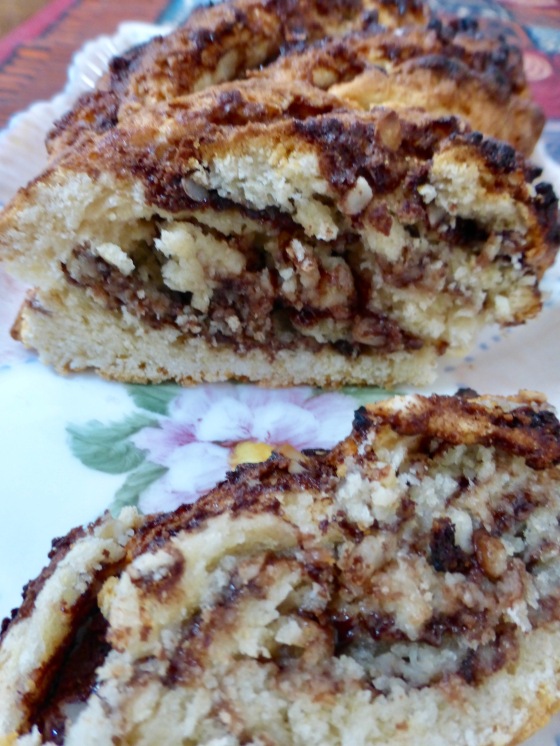
We are now well into autumn with winter just round the corner. To be honest with you, I used to hate autumn and winter. I am an outdoor sort of guy and used to hate winter as the cold and wetter weather tended to hinder any outdoor activities. I used to hate autumn as it was the herald of winter!
As I now tend a fairly large allotment, orchard and gardens I find I no longer hate winter. With all the pruning and clearing I have to do to make ready for the next year I tend to find that I actually run out of time. Spring arrives before I am ready to welcome it! As for autumn, I have started to enjoy the wild autumn harvest. I am currently collecting edible chestnuts and the mushroom season should be starting relatively soon.
What I haven’t managed to accept is the changing of the clocks in autumn, and I know I am not the only one who prefers to enjoy a little more light in the evenings after a day of toil. The Balearic Islands here in Spain were strongly against moving the clocks back, but eventually were forced to do so by the Spanish government. I understand there were also similar sentiments on the Mediterranean coast.
Of course we are told that moving the clocks back and forwards in autumn and spring saves money. I have often wondered if this is in fact the case. The first country to adopt the practice was Germany during the first World War. Things have changed in a hundred years, and in a world that never sleeps are there really any savings?
Well…… I have just read a study by the Spanish IDAE which is the the Institute for Diversification and Saving (Ahorro in Spanish) of Energy. They state that Spanish households save 90 Million Euros due to the changing of the clocks. I am not sure how they measure this, as I am not sure how they manage to get a baseline to work from, but let’s just accept the figures as they are.
It sounds like a lot of money right? it sounds like the right thing to do…… but let’s have a look at those figures again. They are large figures, but let’s put them into perspective. The people of Spain save 90 Million Euros, but given that there are just over 46 million people living in Spain, that makes a saving of around 2€ per person! I would certainly hand over 2€ to have more light in the evenings to enjoy as I like after a day at work.
As I said above, the Balearic Islands were fighting to change the law and not move the clocks back in autumn, perhaps they are not so daft after all?
So, what about the recipe for this week…… well there are quite a few recipes out there for a rolled then plaited stuffed bread. In the region where I live there is also a traditional sweet plaited pastry. These plaits might be all the rage at the moment, but they are not necessarily something new.
Looking for something that little bit different, what I have for you today is a plait made from biscuit dough. The dough in question is quick and easy to make and requires no resting. This plait can in fact be made and baked quickly and easily.
I decided to add some chopped almonds to the chocolate because I have just harvested the almonds from our tree. It is just the one tree, but it keeps us well supplied with almonds for the whole year. You will be seeing more almond recipes over the coming weeks.
Chocolate Spread Biscuit Plait
Makes 9
Ingredients:
Dough:
225g Plain flour
1 1/4 tsp Salt
75g Sugar
15ml Baking powder
50g Butter
125ml Milk
100g Chocolate Spread
25g Almonds
Method:
Take the chocolate spread out of the fridge to allow it to reach room temperature.
To make the dough:
Sift together the flour, salt, sugar and baking powder. Rub in the butter. Add the milk and cut in until if forms a dough.
For more details on rubbing in please click here.
For more details on cutting in please click here.
Roll out the dough to around 30cm by 40cm.
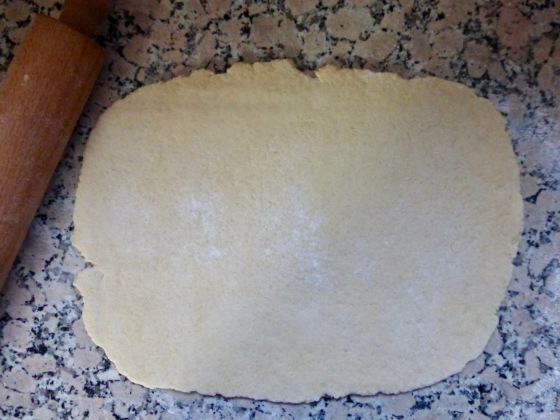
Spread a thin layer of chocolate spread onto the dough.
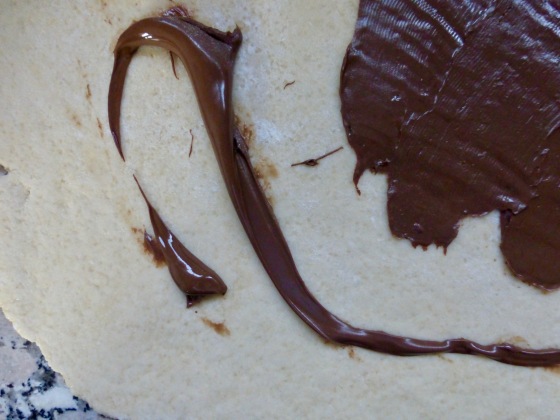
Roughly chop the almonds and sprinkle onto the chocolate layer.
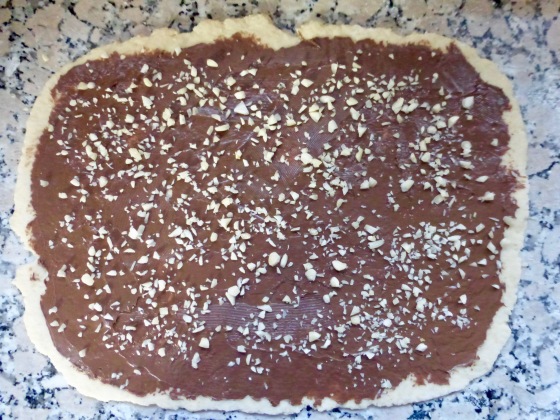
Roll up carefully along the long edge. Trim the ends to make a neat finish to the dough log. Place cut side down onto a greased baking tray.
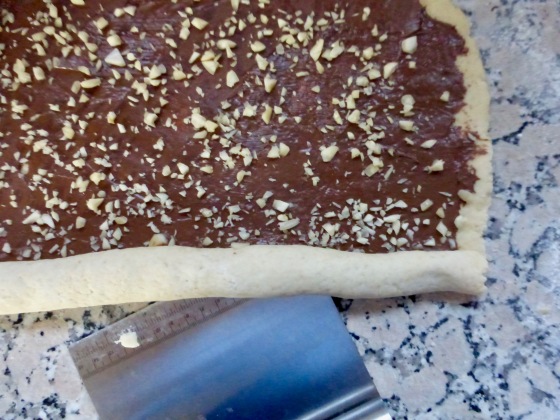
Preheated oven at 230°C.
Cut the log in half lengthways without going right to one of the ends. Leaving one of the ends uncut helps to hold the plait together when platting.

Twist the two strands slightly so that the cut section is uppermost.
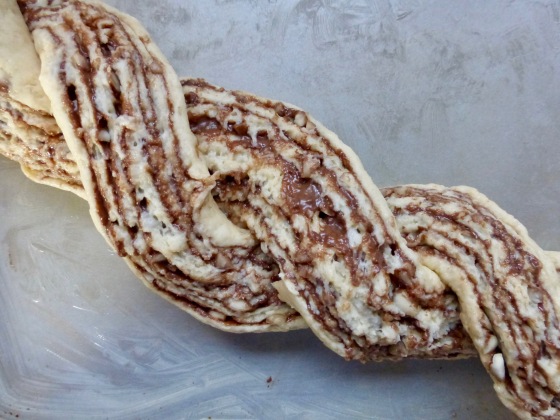
Plat the two strands together, pressing the very end of the two strands against each other gently to finish off the plait.
Bake for 10 to 15 minutes or until the plait is a golden brown.
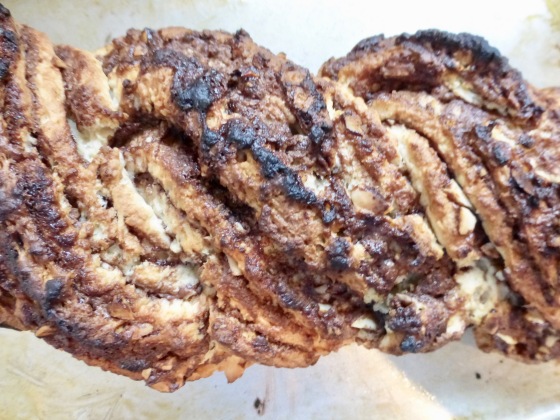
Make sure you choose a soft, spreadable chocolate spread. If not you may find it too hard to spread easily and it can break the rolled out biscuit dough.
For something different, instead of chocolate you might like to try a cinnamon flavour plait. Make and roll out the dough in the same way, but instead of using chocolate spread melt a little butter and paint over the dough. Sprinkle with a good quantity of brown sugar then a good dusting of cinnamon. Roll up and bake in the same way as described above.
Suggested Links:
Other dishes with almonds:
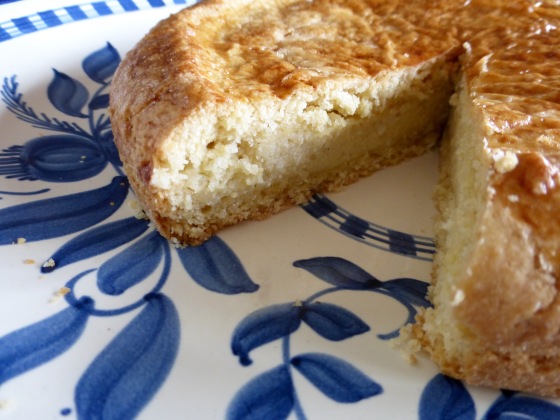
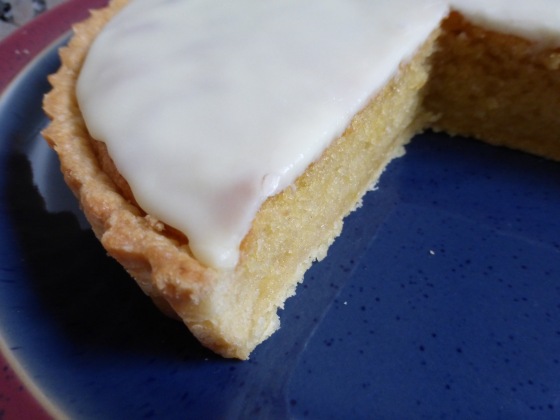
Key:
tsp – Teaspoon – 5ml
tbsp – Tablespoon – 15ml
Imperial to Metric Measurement:
1 oz – 28g
1 lb – 16 oz – 454g
1 gill – ¼ pint – 142ml
2016 Lincoln W. Betteridge
Pingback: Chocolate Spread Biscuit Plait | Other Man's Flavours
Smart thoughts and a really tasty recipe!!!!
LikeLike
Hello Teresa,
Thanks as always for your comments. I think the plait turned out well and is unlike the other ones out there. I must admit to a liking for our local ones though. One of these days I must try making a “Trenza de Almudevar”!
LikeLike